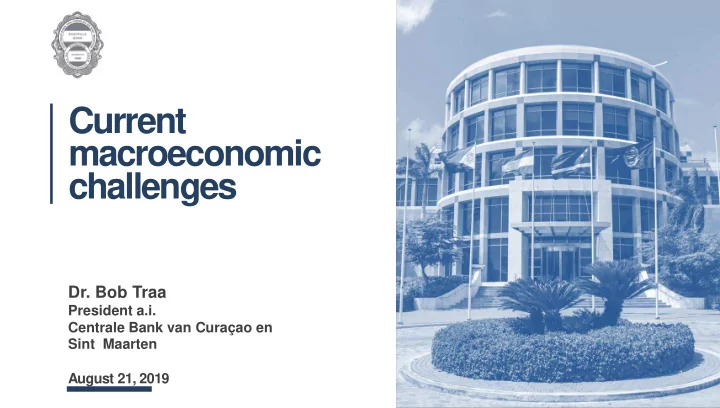

Current macroeconomic challenges Dr. Bob Traa President a.i. Centrale Bank van Curaçao en Sint Maarten 1 August 21, 2019
Contents Diagnosis: What is happening? Policy options: Can we do something about it? 2
Productivity trend is negative Why is this happening and what does this mean? • Growth in output per worker is negative on trend for Curaçao. • The aspirational number is +1½ percent a year. • The population of working age persons is shrinking (cyclical but watch aging). • Fewer potential workers combined with slowing productivity means that potential output growth is negative. • Income and wages are determined by productivity — negative productivity growth means that income and wages 3 will decline.
Productivity trend is negative Labor Productivity 130,000 120,000 110,000 100,000 90,000 80,000 70,000 60,000 50,000 2000 2002 2004 2006 2008 2010 2012 2014 2016 2018 Labor productivity (Real GDP/E) Aspirational number 4
Working-age population is shrinking Working-age population (% change) 15.0 10.0 5.0 0.0 -5.0 -10.0 -15.0 -20.0 2000 2002 2004 2006 2008 2010 2012 2014 2016 2018 5
Negative potential growth 6
Productivity trend is negative • When productivity declines, firms reduce employment to lower costs — unless wages can be adjusted downward. This is the force behind increasing unemployment. • Negative productivity growth means that the economy is becoming less efficient — the supply side is shrinking. • Is negative productivity growth the result of a shrinking capital stock (too much unused capital e.g., houses and hotels)? • Sectoral shifts indicate structural change — this can explain lower productivity during the transition. Light at the end of the tunnel…(more on this later). 7
Labor is unemployed Unemployment rate (%) 25.0 20.0 15.0 10.0 5.0 0.0 2000 2002 2004 2006 2008 2010 2012 2014 2016 2018 8
Capital stock is unemployed 9
Capital stock is unemployed 10
Liquidity is unemployed 1,200 1,000 800 (NAf. million) 600 400 200 0 -200 11 Free reserves Estimate reserves for transaction and precautionary purposes
Sectoral shift Real growth (%) in 2018 10.0 8.1 5.0 0.0 -5.0 -10.0 -15.0 -14.9 -20.0 Restaurants & Hotels Manufacturing 12
Competitiveness is not OK • The real effective exchange rate (REER) indicates relative price competitiveness. • Flat REER does not mean that competitiveness is OK! • The islands are small open economies on a fixed exchange rate — they are price takers and cannot influence prices. The REER is going to be flat (by force). • What matters is not just prices, but costs and efficiency — productivity (!) • Are profit margins adequate, falling, or rising? • Is FDI coming in? • Is employment expanding? 13 • Is the current account of the BOP in good shape?
Real exchange rate 115 110 105 100 95 90 85 2000 2002 2004 2006 2008 2010 2012 2014 2016 2018 Real Effective exchange rate (excl Venezuela) RER, bilateral with US 14
High current account deficit Curaçao: current account balance as % GDP 5.0 0.0 -5.0 -10.0 -15.0 -20.0 -25.0 -30.0 2007 2008 2009 2010 2011 2012 2013 2014 2015 2016 2017 2018 15
Policy: Manage aggregate demand and aggregate supply • Aggregate demand tools: (1) fiscal and (2) monetary policy. • Should we stimulate demand? • Is domestic absorption of output bigger than domestic supply of output? Look at the BOP and NIR. • Can fiscal policy stimulate demand? Is there financing space? Is the debt under control? Is the structure of taxes and budget expenditures supportive of economic activity or inefficient and highly distorting (in revenue: tax consumption, not production and income; in expenditure: maintain education and public investment spending, be careful with subsidies)? 16
Fiscal adjustment has a (symmetric) speed limit • Aanwijzing: If we try to adjust fiscal policy too quickly, then GDP could shrink faster (“stall the engine”) and the debt ratio may even go up. Fiscal adjustment has a speed limit that can be calculated. • Don’t adjust faster than 2 percent of GDP a year, unless the financing constraint forces your hand (Greece). • Discuss with the Netherlands. • Groeiakkoord: Good to upgrade public administration and civil service efficiency. Ministry of Finance needs better and more recent data. 17
Pace of fiscal adjustment Change in primary balance 3.0% 2.0% 1.0% 0.0% -1.0% -2.0% -3.0% 2012 2013 2014 2015 2016 2017 2018 2019* Fiscal adjustment Treshold 18 2019* = projection of the CBCS
Can monetary policy stimulate demand? (Can we print money?) • What is the BOP position? NIR? • On a peg, what leeway is there for monetary policy? • Is the banking system competitive and efficient? • Is credit growing or falling? • The economic dynamics of Sint Maarten versus Curaçao complicates monetary policy: • Sint Maarten’s recession is V-shaped. • Curaçao’s recession is L-shaped. • This has implications for economic policy and the speed of adjustment in both countries. 19
Monthly import coverage 6 5 4 Months 3 2 1 0 20 Import coverage norm Import coverage
Private credit extension (year-on-year growth) 6.0% 5.0% 4.0% 3.0% 2.0% 1.0% 0.0% -1.0% -2.0% 21
The role of structural policies • How do we boost aggregate supply and potential growth? • How do we make the economy more efficient and productive? • This requires structural reforms : in labor markets and product markets, and government. • Never do only labor or only product market reforms, because this disturbs the market equilibrium (use balance). 22
The policy approach • In an economy in structural flux, reforms are necessary to re-allocate resources. More flexibility means quicker progress and less macroeconomic pain. More rigidity means lower growth, higher unemployment, lower investment, and a longer time to reset the economy. • Protect people, do not protect jobs (entitled positions) — that is the essence of flexicurity . • Polder model (a tripartite solution). 23
Solutions require data • Curaçao and Sint Maarten need better data: • More data • High-quality data • The Prime Ministers are special pilots. 24
THEEND 2 5
Recommend
More recommend